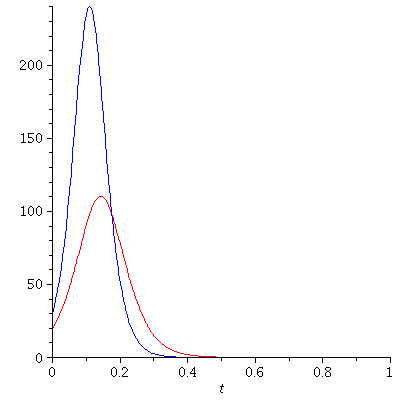Suppose that we have a homogeneously mixing group of individuals of total size $n+1$ and that the epidemics is started off at $t=0$ by one individual becoming infectious. The remaining $n$ individuals are susceptible. Denote by $x$ and $y$ the numbers of susceptibles and infectives, respectively. Then $x+y=n+1$. Also suppose that the rate of occurrence of new infections is proportional to the number of infectives as well the number of susceptibles. Then we obtain the following differential equation \begin{equation}\label{eq:infectrate}\frac{dx}{dt}=-\beta xy=-\beta x(n-x+1)\end{equation} where $\beta$ is the constant of proportionality called the infection-rate. Let $\tau=\beta t$. \eqref{eq:infectrate} becomes \begin{equation}\label{eq:infectrate2}\frac{dx}{d\tau}=-x(n-x+1)\end{equation} With initial condition $x(0)=n$, the solution of \eqref{eq:infectrate2} is given by $$x(\tau)=\frac{n(n+1)}{n+e^{(n+1)\tau}}$$ The number of infectives at $\tau$ is then given by $$y(\tau)=\frac{n+1}{1+ne^{-(n+1)\tau}}$$ The rate at which new infectives accrue $$w(\tau)=\frac{dy}{d\tau}$$ is called the epidemic curve. It follows from \eqref{eq:infectrate2} that $$w(\tau)=-\frac{dx}{d\tau}=-xy=\frac{n(n+1)^2e^{(n+1)\tau}}{[n+e^{(n+1)\tau}]^2}$$ Using the standard argument from calculus, we find that $w(\tau)$ assumes its maximum when $x=y$ i.e. when the number of susceptibles and the number of infectives are the same and that happens when $\tau=\frac{\ln n}{n+1}$, and the maximum rate at which new infections accrue is $w=\frac{1}{4}(n+1)^2$.

As a reminder the model we discussed above assumed that the epidemic is started off by one individual (patient zero). Now, we want to generalized the model by assuming that the epidemic is started off by several infectious individuals. Let $x(0)=n$ and $y(0)=a$. Then the equation \eqref{eq:infectrate2} is modified to \begin{equation}\label{eq:infectrate3}\frac{dx}{dt}=-x(n-x+a)\end{equation} The solution of \eqref{eq:infectrate3} is $$x(\tau)=\frac{n(n+a)}{n+ae^{(n+a)\tau}}$$ The corresponding epidemic curve is given by $$w=\frac{an(n+a)^2e^{(n+a)\tau}}{[n+ae^{(n+a)\tau}]^2}$$ Let $W=\frac{w}{n}=\frac{a(n+a)^2e^{(n+a)\tau}}{[n+ae^{(n+a)\tau}]^2}$, $0\leq\tau<\infty$. Then \begin{align*}\int_0^\infty Wd\tau&=\int_{n+a}^\infty\frac{(n+a)}{u^2}du\ (u=n+ae^{(n+a)\tau})\\&=1\end{align*} So, $W$ can be interpreted as the probability density of a new infection occurring. The mean value of the variable $\tau$ is \begin{align*}\bar\tau&=\int_0^\infty\tau Wd\tau\\&=-\frac{1}{n}\int_0^\infty\tau\frac{dx}{d\tau}d\tau\\&=\frac{1}{n}\ln\left(1+\frac{n}{a}\right)\end{align*}
References:
- Norman T. J. Bailey, A Simple Stochastic Epidemic, Biometrika, Vol. 37, No. 3/4 (Dec., 1950), 193-202.
- The Mathematical Theory of Infectious Diseases and Its Applications, Norman T. J. Bailey, Second Edition, Charles Griffin & Company LTD, 1975.
